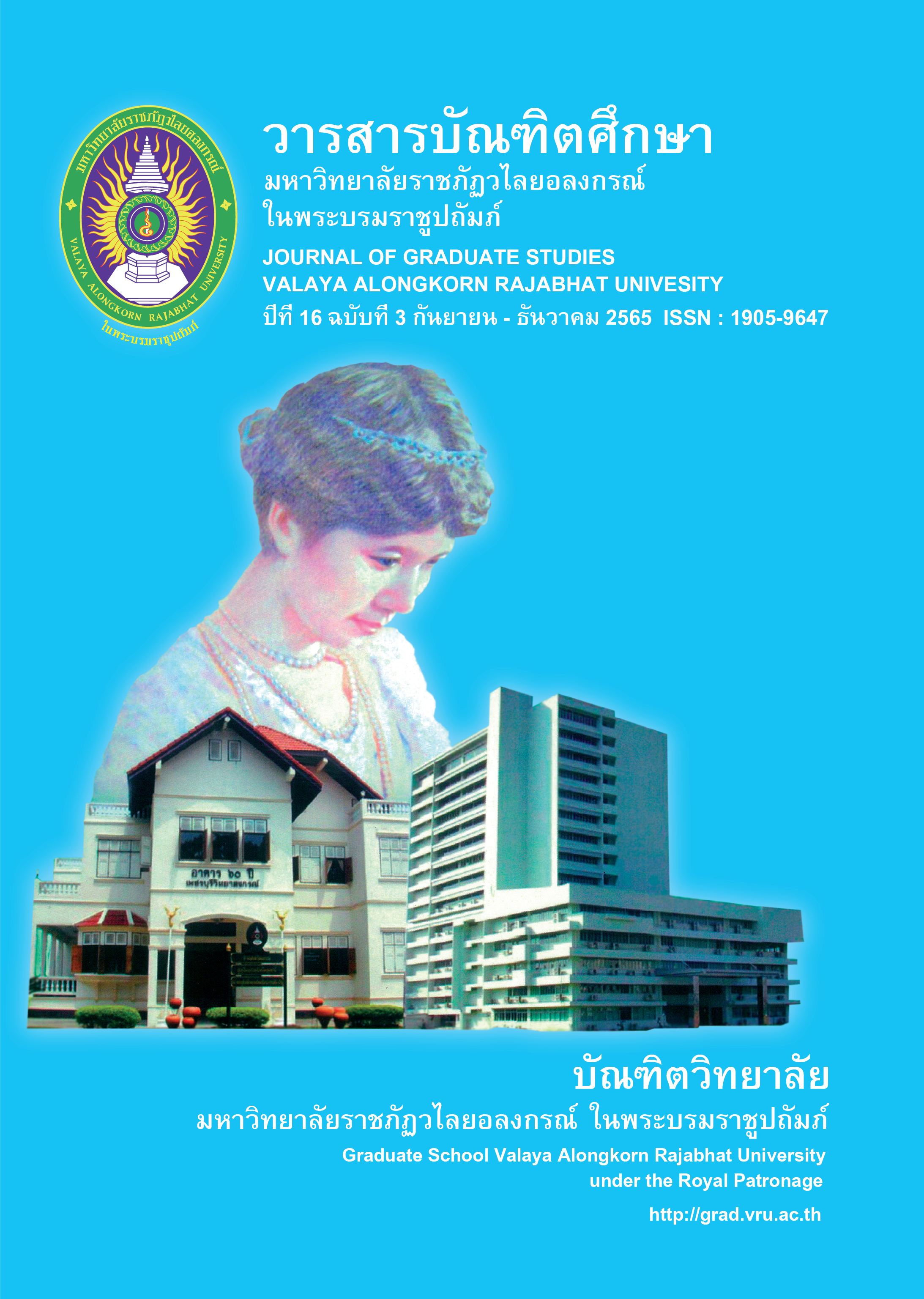THE DEVELOPMENT OF THE CREATIVE LEADERSHIP PROGRAM FOR DEVELOPING THE GENERAL PRIVATE EDUCATION TEACHERS IN REGIONAL EDUCATION OFFICE NO.1
Main Article Content
Abstract
The objectives of this research were 1) to develop the creative leadership program for developing the private general education teachers in regional education office no.1, 2) to experiment and evaluate the creative leadership program, and 3) to modify the creative leadership program. The samples were purposive sampling 30 Intamoleepratan’s teachers. Research instruments were the creative leadership program, pre-posttest, evaluation assessment form and behavior observation analyzing the data by frequency, mean, standard deviation, and t-test.
The result revealed that: 1) the creative leadership program for developing the private general education teachers in regional education office no.1 consisted of (1) principles and concepts (2) objectives (3) content, there were 2 modules: the first module was the creative leadership consisted of (1) leadership (2) creative leadership (3) vision and (4) imagination and the second module was the flexibility consisted of (1) meaning and importance of flexibility and (2) the type of flexibility 4) activities
5) media/material and 6) evaluation. 2) The result of experimentation and evaluation had been showed by the t-test were different as statistically significant at .05 which meant that the learning and behavior change were taking place and 3. The creative leadership program was modified by adding more detail in the content as in the first module obviously.
Article Details

This work is licensed under a Creative Commons Attribution-NonCommercial-NoDerivatives 4.0 International License.
บทความทุกเรื่องได้รับการตรวจความถูกต้องทางวิชาการโดยผู้ทรงคุณวุฒิ ทรรศนะและข้อคิดเห็นในบทความวารสารบัณฑิตศึกษา มหาวิทยาลัยราชภัฏวไลยอลงกรณ์ ในพระบรมราชูปถัมภ์ มิใช่เป็นทรรศนะและความคิดของผู้จัดทำจึงมิใช่ความรับผิดชอบของบัณฑิตวิทยาลัย มหาวิทยาลัยราชภัฏวไลยอลงกรณ์ ในพระบรมราชูปถัมภ์ กองบรรณาธิการไม่สงวนสิทธิ์การคัดลอก แต่ให้อ้างอิงแหล่งที่มา
References
Bandura, A. (1986). Social foundation of thought and action: A social cognitive theory. Englewood Cliffs, NJ: Prentice-Hall Inc.
Bennis, W. (2002). Creative leadership. Executive Excellence.
Boripun, A. (2020). prōkrǣm phatthanā phāwa phū nam fai bō̜rikān khō̜ng bukkhalākō̜n nai samnakngān khēt phư̄nthī kānsưksā prathom sưksā [The development for a servant leadership program for personnel under the office of primary education service area]. Doctoral dissertation. Sakon Nakhon Rajabhat University.
Casse, P., & Claudel, P. G. (2007). Philosophy for creative leadership: How philosophy can turn people into more effective leaders. Athena Press, p. 280.
Chantaraphakdee, P. (2005). kānphatthanā phāwa phū nam yaowachon radap matthayommasưksā tō̜n plāi rōngrīan matthayommasưksā samnakngān khana kammakān kānsưksā naphư̄n thān krasūang sưksāthikān dōi chai krabūankān laksūt [Development of youth leadership development for senior high school students in high school under the office of the basic of the basic education commission, the ministry of education through curriculum development]. Doctoral dissertation. Naresuan University.
Chareonwongsak, K. (2010). kān khit chœ̄ng wikhro̜ [Analytical thinking]. Bangkok: Success Media Co.Ltd.
Chernin, P. (2001). Creative leadership: The strength of ideas the power of the Imagination. Vital Speeches of the Day: Xlibris, Corp.
Coughlin. (2005). Principles and leadership. Englewood Cliff’s Prentice-Hall.
Counter, R. A. (2002). To give their gifts: Health, community and democracy. Nashville: Vanderbilt University Pr.
Danner, S. E. (2008). Creative leadership in art education: Perspectives of an art educator. Thesis Master of Arts, Art Education, Fine Art: Ohio University.
Dubrin. (2013). Principle of leadership. 7th edition: South-west Cengage Learning.
Gannon, B. K. (1998). A Curriculum in psychology for managers: Education leaders for the new millennium. Doctoral dissertation. Massachusetts, School of Profession Psychology.
Guntern, G. (2004). The challenge of creative leadership: Maya Angelou Press.
Kaminker, J. P. (2011). The leadership factors. London, UK: Collier Macmillan.
Kirkpatrick, D., & Kirkpatrick, J. (2009). Evaluating training programs: The four levels third edition. San Francisco, CA: Berrett-Koehler.
Lussier, N. & Achua, F. (2007). Effective leadership. Ohio 3rd edition: South-Western.
Ninchawee, W. (2007). kānsưksā kānmī sūanrūam khō̜ng kammakān sathān sưksā nai kānkamnot wisaithat khō̜ng rōngrīan sangkat samnakngān khēt phư̄nthī kānsưksā sakǣo khēt nưng [The study of the participation of the school board members in determining vision of the schools under the jurisdiction of the Sa kaeo education service area 1]. Master’s thesis. Valaya Alongkorn Rajabhat University.
Palus, C. J., & Horth, D. M. (2005). The leader’s edge: Six creative competencies for navigating complex challenges. San Francisco: Jossey Bass.
Parker, J. P., & Begnaud, L. G. (2004). Developing creative leadership. Portsmouth. NH: Teacher Ideas Press.
Regional education office no.1. (2019). rāingān sarup phonkān čhat prachum chœ̄ng patibatkān kān thopthūan phǣn yutthasāt kānphatthanā kānsưksā phāk nưng Phō̜.Sō̜. sō̜ngphanhārō̜ihoksipsām sō̜ngphanhārō̜ihoksiphā [Summary report “Review the plan of the educational development strategy, region 1 2020-2022]. Retrieved from www.reo1.moe.go.th.
Reuter, P. (2011). Doped: How two plants wreak havoc on the countries that produce and consume them and everyone in between Foreign Policy. Retrieved from www.foreignpolicy.com/articles/2009/10/19/prime_numbers_doped?page=0,2.
Sararattana, W. (2014). phāwa phū nam: thritsadī læ nānā thatsana rūamsamai patčhuban [Leadership: Theory and various perspective of contemporary]. Bangkok: Thipvisut.
Schleicher, A. (2020). How can we foster creativity in school-and how will we know we are actually doing so?. Retrieved from www.facebook.com/OECDEduSkills.
Sinlarat, P. (2020). yutthakān plīan khrū chœ̄i sū khrū yuk satawat thī yīsipʻet [The battle of turning ‘Kru Chai’ into 21st century teachers]. Retrieved from www.seminar.qlf.or.th/Seminar/Topic/29.
Sousa, D. (2003). The leadership brain: How to lead today’s schools more effectively. Thousand Oaks: Sage.
Stoll, L., & Temperley, J. (2009). Creative leadership: A challenge of our times. School leadership and Management.
Sutharat, W. (2004). khwāmkhit læ khwāmkhit sāngsan [Thinking and creative thinking]. Bangkok: Suveiriyasan Co. Ltd.
Thanaseelangkun, C. (2016). kānphatthanā laksūt fưk ʻoprom phư̄a songsœ̄m phāwa phū nam chœ̄ng sāngsan samrap naksưksā khrū mahāwitthayālai rātchaphat Nakhō̜n Rātchasīmā [The curriculum development of creative leadership encouraging for teacher students Nakhonratchasima Rajabhat University]. Journal of Education Khon Kaen University. 39(4), 65-73
UNESCO. (1997). kānrīanrū : khum sap nai tūa ton [Learning: The treasure within]. n.d. Worachin, T. (2016). rūpbǣp kānphatthanā phāwa phū nam chœ̄ng sāngsan khō̜ng phūbō̜rihān sathān sưksā sangkat samnakngān khēt phư̄nthī kānsưksā matthayommasưksā khēt 24 [A creative leadership development model for the school directors of the secondary educational service aree office 24]. Doctoral dissertation. Mahasarakham Rajabhat University.


